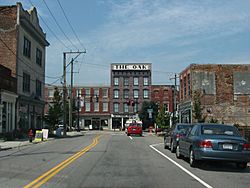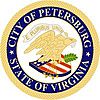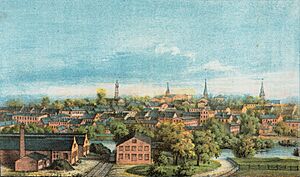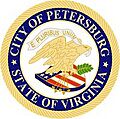Petersburg, Virginia facts for kids
Quick facts for kids
Petersburg, Virginia
|
|||
|---|---|---|---|

Downtown Petersburg
|
|||
|
|||
| Nickname(s):
"The Cockade City"
|
|||
| Country | United States | ||
| State | Commonwealth of Virginia | ||
| County | None (Independent city) |
||
| Founded | December 17, 1748 | ||
| Area | |||
| • Total | 22.94 sq mi (59.42 km2) | ||
| • Land | 22.72 sq mi (58.85 km2) | ||
| • Water | 0.22 sq mi (0.58 km2) | ||
| Elevation | 134 ft (40 m) | ||
| Population
(2020)
|
|||
| • Total | 33,458 | ||
| • Density | 1,458.5/sq mi (563.08/km2) | ||
| Time zone | UTC-05:00 (EST) | ||
| • Summer (DST) | UTC-04:00 (EDT) | ||
| ZIP codes |
23803–23806
|
||
| Area code(s) | 804 and 686 | ||
| FIPS code | 51-61832 | ||
| GNIS ID | 1497087 | ||
Petersburg is a city in Virginia, United States. It is an "independent city," meaning it is not part of a larger county. In 2020, about 33,458 people lived there. Most of the people living in Petersburg are Black Americans.
The city is located about 21 miles (34 km) south of Richmond, which is the capital of Virginia. Petersburg sits on the Appomattox River, where the river drops from higher land to lower land. This spot was important because boats could not travel further upstream. This made it a great place for trade and building mills.
In 1645, a fort called Fort Henry was built here. This fort helped attract traders and settlers. Petersburg officially became a town in 1748 and then a city in 1850. It grew into a major center for transportation and factories.
Petersburg was a key city during the American Civil War (1861–1865). Its many railroads made it important for supplying the Confederate capital, Richmond. The Siege of Petersburg lasted for nine months in 1864–65. This included the famous Battle of the Crater and a lot of trench warfare. Today, parts of these battlefields are protected as the Petersburg National Battlefield.
Petersburg is also known for having some of the oldest free Black settlements in Virginia, like Pocahontas Island. Two of the oldest Black churches in the United States are also found here. These churches played a big role in the Civil Rights Movement in the 1950s and 1960s. Virginia State University, a historically Black college, is located nearby.
Today, Petersburg is still an important transportation hub. Major highways like Interstate 85 and 95 pass through it. Train services also connect the city to other places. The city uses its rich history to attract visitors and new businesses. The U.S. Army's Fort Gregg-Adams is also a major employer in the area.
Contents
- Exploring Petersburg's Past
- Where is Petersburg?
- Petersburg's Weather
- Who Lives in Petersburg?
- Petersburg's Economy
- Getting Around Petersburg
- Arts and Culture in Petersburg
- Sports in Petersburg
- Schools and Learning in Petersburg
- Famous People from Petersburg
- Images for kids
- See also
Exploring Petersburg's Past

Early Native American Life
Long before Europeans arrived, Native Americans lived in the Petersburg area. Digs on Pocahontas Island show that people lived there as far back as 6,500 BCE.
When English settlers came in 1607, the local tribe was the Appamatuck. They were part of the powerful Powhatan Confederacy. They had a town near what is now Petersburg.
How Petersburg Was Founded
English colonists founded Petersburg at a key spot on the Appomattox River. In 1646, the Virginia Colony built Fort Henry near the river's falls. These falls provided power for mills.
Around 1675, Peter Jones, who was in charge of the fort, opened a trading post. It was called Peter's Point. In 1733, a man named William Byrd II planned a city here, calling it Petersburgh. The Virginia government officially made Petersburg a town in 1748.
Petersburg During the Revolutionary War
During the American Revolutionary War (1775–1783), Petersburg saw fighting. The Battle of Blanford happened just east of the city in 1781. British forces captured Petersburg, but they didn't win the war. The British army later surrendered at Yorktown.
After the war, Petersburg grew by adding nearby towns. During the War of 1812, local soldiers called the Petersburg Volunteers fought bravely. President James Madison called Petersburg "Cockade of the Union" because of their courage. This led to the city's nickname, "Cockade City."
The Free Black Community in Petersburg
Petersburg was home to a large community of free Black Americans. They founded the First Baptist (1774) and Gillfield Baptist Church (1797). These are two of the oldest Black congregations in the United States.
Many free Black people moved to Petersburg, even with strict laws against them. By 1860, nearly 26% of all free people in Petersburg were Black. This was the highest percentage in any Southern city. Free Black men worked in factories and as skilled workers. Free Black women worked in factories or as seamstresses.
Pocahontas Island became a main area for free Black residents. It was an important stop on the Underground Railroad, helping enslaved people escape to freedom.
Petersburg Before the Civil War
Before the Civil War, Petersburg became a major industrial city in the South. It was the 11th largest city in slave states. Factories processed cotton, tobacco, and metal. Petersburg and Richmond became the world's biggest tobacco towns.
The city also became a railroad hub. By 1860, four railroads connected Petersburg to other areas. This helped move goods and people, making Petersburg a very important city for trade.
Petersburg and the Civil War
At the start of the American Civil War in 1861, Petersburg was Virginia's second-largest city. It was vital for the Confederate war effort. The city sent many soldiers and helped build defenses. Over 300 free Black Americans volunteered to work on fortifications.
The Siege of Petersburg
In 1864, Union General Ulysses S. Grant targeted Petersburg. He wanted to cut off the railroads that supplied Richmond, the Confederate capital. The Siege of Petersburg began on June 9, 1864, and lasted 292 days.
During the siege, the Union forces suffered a big loss at the Battle of the Crater. Over 4,000 soldiers were hurt or killed. Finally, in April 1865, Union troops cut off Petersburg's last railroad lines. This forced the Confederate army to retreat.
The fall of Petersburg meant Richmond could no longer be defended. Confederate General Robert E. Lee surrendered his army at Appomattox Court House on April 9, 1865. This ended the Civil War.
Rebuilding After the War
After the Civil War, many freed slaves moved to Petersburg. They started new churches, businesses, and organizations. The damaged railroads were repaired.
In 1882, Virginia State University was founded nearby. It was one of the first public colleges for Black students in the Mid-Atlantic. This helped improve education for Black Americans.
Petersburg in the 20th Century
In the early 1900s, Virginia passed "Jim Crow" laws. These laws created racial segregation and took away voting rights from most Black citizens.
After World War II, Black Americans in Petersburg fought for equal rights. They wanted to end segregation and get their voting power back. In 1949, a local politician named Remmie Arnold promised to treat all Virginians fairly, which was unusual for the time.
The Civil Rights Movement
Petersburg's Black churches, like First Baptist and Gillfield Baptist, were central to the Civil Rights Movement. Dr. Wyatt Tee Walker, a pastor at Gillfield Baptist, helped start the Southern Christian Leadership Conference (SCLC) with Dr. Martin Luther King Jr..
In the 1950s, Black Americans in Petersburg worked to desegregate public schools and facilities. When the city closed a popular swimming lake to prevent integration, activists protested. Through sit-ins, they helped desegregate lunch counters in the city.
Virginia leaders strongly opposed school integration. Some schools in other parts of Virginia were even closed to avoid it. In Petersburg, a private school opened for white students to avoid integration.
Economic Challenges and Changes
Petersburg faced economic challenges in the late 20th century. Many factories closed, and jobs were lost. New highways led people to move to suburbs outside the city.
In 1971, Petersburg tried to annex (take in) land from nearby counties to expand its tax base. This added many white residents. Black civil rights groups argued that this was done to reduce the voting power of Black citizens. A judge agreed and ordered the city to create voting districts to ensure fair representation.
In the late 1980s, many stores moved from downtown Petersburg to a new mall in a nearby town. This hurt Petersburg's economy. Civil rights activists organized a boycott of the new mall to push for more job opportunities for Black residents.
In the 1990s, Petersburg worked to restore its historic buildings. In 1993, a strong tornado hit downtown, damaging many restored buildings.
Petersburg Today
In the 21st century, Petersburg's downtown, called Old Towne, has seen new businesses open. These include restaurants, shops, and apartments. The nearby Fort Gregg-Adams has expanded, bringing more jobs to the area.
In 2022, Virginia's governor and Petersburg's mayor started the "Partnership for Petersburg." This plan aims to improve education, public safety, health, and transportation in the city.
Where is Petersburg?
Petersburg is located at 37°12′46″N 77°24′1″W / 37.21278°N 77.40028°W.
The city covers about 23.2 square miles (60.1 km²). Most of this is land, with a small amount of water.
Petersburg is on the Appomattox River at the fall line. This is where the rocky Piedmont region meets the flat Atlantic coastal plain. Rivers often have rapids or waterfalls at the fall line. This spot was important because it was as far as boats could travel inland. It also provided water power for mills.
Petersburg is about 21 miles (34 km) south of Richmond. It is also where two major highways, Interstates 95 and 85, meet. Petersburg is part of the larger Richmond-Petersburg area.
The U.S. government groups Petersburg with nearby cities and counties for statistics. This area is known as the "Appomattox Basin."
Nearby Areas
- Chesterfield County, Virginia—north
- Colonial Heights, Virginia—north
- Dinwiddie County, Virginia—west, south
- Prince George County, Virginia—east, southeast
Protected Natural Areas
Petersburg's Weather
| Climate data for PETERSBURG, VA, 1991-2020 normals | |||||||||||||
|---|---|---|---|---|---|---|---|---|---|---|---|---|---|
| Month | Jan | Feb | Mar | Apr | May | Jun | Jul | Aug | Sep | Oct | Nov | Dec | Year |
| Mean daily maximum °F (°C) | 49.1 (9.5) |
52.2 (11.2) |
60.1 (15.6) |
70.4 (21.3) |
78.2 (25.7) |
85.5 (29.7) |
89.3 (31.8) |
87.4 (30.8) |
81.5 (27.5) |
71.6 (22.0) |
61.5 (16.4) |
52.6 (11.4) |
70.0 (21.1) |
| Daily mean °F (°C) | 38.7 (3.7) |
40.7 (4.8) |
48.1 (8.9) |
58.0 (14.4) |
66.6 (19.2) |
74.8 (23.8) |
79.2 (26.2) |
77.4 (25.2) |
71.1 (21.7) |
59.8 (15.4) |
49.4 (9.7) |
41.6 (5.3) |
58.8 (14.9) |
| Mean daily minimum °F (°C) | 28.3 (−2.1) |
29.1 (−1.6) |
36.1 (2.3) |
45.6 (7.6) |
55.0 (12.8) |
64.2 (17.9) |
69.0 (20.6) |
67.3 (19.6) |
60.8 (16.0) |
48.0 (8.9) |
37.3 (2.9) |
30.6 (−0.8) |
47.6 (8.7) |
| Average precipitation inches (mm) | 3.02 (77) |
2.70 (69) |
4.37 (111) |
3.62 (92) |
4.37 (111) |
4.23 (107) |
4.70 (119) |
5.31 (135) |
4.63 (118) |
3.41 (87) |
3.16 (80) |
3.47 (88) |
46.99 (1,194) |
| Average precipitation days (≥ 0.01 in) | 9.3 | 8.9 | 9.8 | 10.6 | 11.6 | 10.0 | 9.2 | 10.4 | 8.3 | 8.6 | 8.7 | 9.8 | 115.2 |
| Source: NOAA | |||||||||||||
Petersburg has a humid subtropical climate. This means it has hot, humid summers and generally mild to cool winters.
Who Lives in Petersburg?
| Historical population | |||
|---|---|---|---|
| Census | Pop. | %± | |
| 1790 | 2,828 | — | |
| 1800 | 3,521 | 24.5% | |
| 1810 | 5,668 | 61.0% | |
| 1820 | 6,690 | 18.0% | |
| 1830 | 8,322 | 24.4% | |
| 1840 | 11,136 | 33.8% | |
| 1850 | 13,950 | 25.3% | |
| 1860 | 18,266 | 30.9% | |
| 1870 | 18,950 | 3.7% | |
| 1880 | 21,656 | 14.3% | |
| 1890 | 22,680 | 4.7% | |
| 1900 | 21,810 | −3.8% | |
| 1910 | 24,127 | 10.6% | |
| 1920 | 31,012 | 28.5% | |
| 1930 | 28,564 | −7.9% | |
| 1940 | 30,631 | 7.2% | |
| 1950 | 35,054 | 14.4% | |
| 1960 | 36,750 | 4.8% | |
| 1970 | 36,103 | −1.8% | |
| 1980 | 41,055 | 13.7% | |
| 1990 | 38,386 | −6.5% | |
| 2000 | 33,740 | −12.1% | |
| 2010 | 32,420 | −3.9% | |
| 2020 | 33,458 | 3.2% | |
| U.S. Decennial Census 1790–1960 1900–1990 1990–2000 2010–2012 |
|||
Population in 2020
In 2020, Petersburg had 33,458 people.
| Race / Ethnicity (NH = Non-Hispanic) | Pop 2010 | Pop 2020 | % 2010 | % 2020 |
|---|---|---|---|---|
| White alone (NH) | 4,902 | 5,178 | 15.12% | 15.48% |
| Black or African American alone (NH) | 25,419 | 24,530 | 78.41% | 73.32% |
| Native American or Alaska Native alone (NH) | 87 | 105 | 0.27% | 0.31% |
| Asian alone (NH) | 263 | 330 | 0.81% | 0.99% |
| Pacific Islander alone (NH) | 12 | 30 | 0.04% | 0.09% |
| Other race alone (NH) | 31 | 190 | 0.10% | 0.57% |
| Mixed race or Multiracial (NH) | 490 | 1,125 | 1.51% | 3.36% |
| Hispanic or Latino (any race) | 1,216 | 1,970 | 3.75% | 5.89% |
| Total | 32,420 | 33,458 | 100.00% | 100.00% |
Most people in Petersburg are Black or African American. There are also White, Asian, Native American, and other racial groups. Some people are of Hispanic or Latino background.
Petersburg's Economy
Petersburg has a long history as a center for factories. Companies like Arnold Pen Co., Seward Trunk Co., and Amsted Rail-Brenco bearings operate here. In the past, it was known for tobacco companies.
Today, large distribution centers for companies like Walmart and Amazon.com are located nearby. These centers provide many jobs for people in the area.
Getting Around Petersburg
Petersburg is well-connected by roads and railways. The city is served by major highways like Interstate 85 and Interstate 95.
Train services by Amtrak also run through Petersburg. There is a bus station with Greyhound service. A local bus system, Petersburg Area Transit, helps people travel within the city and the surrounding "Tri-Cities" area.
For air travel, Richmond International Airport is less than 30 miles (48 km) north of Petersburg.
Main Roads in Petersburg
Arts and Culture in Petersburg
Petersburg has worked hard to preserve its historic buildings. The city has many old structures from the 1700s, 1800s, and 1900s. These buildings give the city a unique feel.
The Petersburg Old Town Historic District is a special area listed on the National Register of Historic Places. People enjoy the historic buildings and walking around downtown. Many old buildings have been turned into new restaurants, shops, and apartments.
The city is also a lively arts center. It has an Arts League and a performing arts center called Sycamore Rouge. They put on plays, live music, and cabaret shows. On the second Friday of each month, the city celebrates "Friday of the Arts," where local art and music are featured.
Pocahontas Island, a historic Black community, is also a listed historic district. Another beautiful old house is Battersea, built in 1767.
Sports in Petersburg
Petersburg has a history with minor league baseball. Teams like the Petersburg Goobers played here from 1885 to 1951. Famous baseball player Sam Rice played for the Goobers.
More recently, the Petersburg Generals played in a summer baseball league at the Petersburg Sports Complex. They won a league championship in their first season in 2000.
Schools and Learning in Petersburg
Public Schools
Petersburg City Public Schools serve students in the city.
High school
- Petersburg High School
Middle school
- Vernon Johns Middle School
Elementary schools
- Cool Springs Elementary School
- Lakemont Elementary School
- Walnut Hill Elementary School
- Blandford Academy K-5
- Pleasants Lane Elementary School
- Westview Early Childhood Education Center
Other Schools
Specialty Schools
- Appomattox Regional Governor's School for the Arts and Technology
- Maggie L. Walker Governor's School for Government and International Studies
Private Schools
- Bermuda Run Educational Center
- Blandford Manor Education Center
- Grace Baptist School
- Restoration Military Academy
- Rock Church Academy
- Robert A. Lewis SDA School
- St. Joseph School
Colleges and Universities
There are three colleges and universities in the Petersburg area:
- Brightpoint Community College
- Richard Bland College
- Virginia State University
Famous People from Petersburg
Many notable people have connections to Petersburg:
- Blair Underwood, actor
- Trey Songz, R&B singer
- Joseph Cotten, actor
- Harold Cruse, social critic and teacher
- Edith Luckett Davis, actress and mother of Nancy Reagan
- Ricky Hunley, NFL defensive player
- Vernon Johns, civil rights leader
- Rudi Johnson, former NFL running back
- John Mercer Langston, abolitionist, educator, and politician
- Kendall Langford, NFL defensive player
- William Mahone, Civil War General and politician
- Frank Mason III, NBA point guard
- Moses Malone, NBA Hall of Fame player
- Jennifer McClellan, U.S. congresswoman
- Afemo Omilami, actor
- Dee Dee Ramone, punk rocker
- Joseph Jenkins Roberts, first president of Liberia
- Winfield Scott, U.S. Army general
- Norman Sisisky, U.S. Representative
- Ricky Smith, Houston Texans general manager
- Wyatt T. Walker, civil rights leader
- Mark West, NBA player
- Shalita Grant, Tony Award-nominated actress
- John M Richardson, Admiral
Images for kids
See also
 In Spanish: Petersburg (Virginia) para niños
In Spanish: Petersburg (Virginia) para niños













